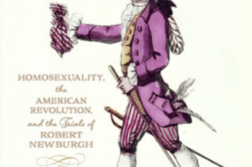IT WOULD BE NO EXAGGERATION to say that in gay historical circles, and more specifically gay religious studies, there is before John Boswell and there is after John Boswell. It can be argued that the 1980 publication of openly gay Yale historian John Boswell’s groundbreaking work, Christianity, Social Tolerance, and Homosexuality: Gay People in Western Europe from the Beginning of the Christian Era to the Fourteenth Century, by replacing one conceptual worldview with a radically different one, gave rise to the kind of paradigm shift that Thomas Kuhn talked about in his landmark 1962 book The Structure of Scientific Revolutions. By analyzing biblical texts from both the Old and New Testament and the historical record up to the 14th century, Boswell upended the traditional Roman Catholic Church’s understanding of its gay members. And so, on the 35th anniversary of the publication of his magnum opus, it seems the right time to analyze this paradigm shift and explore the impact of such an intellectual and spiritual upheaval in the intervening decades.
Prior to 1980, there really had been only two favorable books written on the subject of homosexuality and Christianity. The first was Derrick Sherwin Bailey’s Homosexuality and the Western Christian Tradition (1955). Bailey was an Anglican priest, his book essentially popularizing a 1954 church commission on “the problem of homosexuality,” which reviewed scripture on the topic. Bailey concluded that using the Bible to condemn homosexuality was not justified, but he conceded that the Catholic Church had in fact denounced homosexuality from its early beginnings.

The second book was John McNeill’s The Church and the Homosexual (1976), the first Catholic work to support the inclusion of gay and lesbian people in the Church. McNeill, a Jesuit priest and ethicist (who died last September), argued there was no moral basis for condemning homosexuality. He used a rough draft of Boswell’s prepublication scriptural analysis to bolster his thesis. Partially in reaction to McNeill, Pope Paul VI issued a letter, “The Declaration on Certain Questions Concerning Sexual Ethics” (1975), acknowledging the concept of sexual orientation (“innate instinct or pathological constitution judged to be incurable”), which was considered at the time to be an advance. However, it also stated: “Scripture does not of course permit us to conclude that all those who suffer from this anomaly are personally responsible for it, but it does attest to the fact that homosexual acts are intrinsically disordered and can in no case be approved of.”







Discussion2 Comments
Bromberger failed to mention one of the three books favorable toward gay Christians that preceded John Boswell’s 1980 Christianity, Social Tolerance, and Homosexuality. In 1978, Harper S.F. published Is The Homosexual My Neighbor? A Positive Christian Response, by Letha Dawson Scanzoni and Virginia Ramey Mollenkott. Written primarily for evangelicals by evangelicals, the books treated the Bible with great respect, discussing various misinterpretations that had made the Bible seem like an enemy to GLBT people. Harvey Milk brought his motorcade to the book-release luncheon in San Francisco shortly before he was murdered. And later, John Boswell and I became good friends when we both spoke at a Lesbian, Gay, and Christian weekend at Kirkridge Conference Center in Pennsylvania.
Hi Virginia. No slighting or disrespect was intended, as I remember reading your wonderful book in my early 20s and realizing Christianity and homosexuality are not mutually exclusive. What you did so effectively was to take often academic arguments and made them accessible to lay (meaning non-theologically trained) audiences, using real life examples..I could easily have cited your book, as well as books by Malcolm Boyd and Troy Perry in that pre-Boswell era, concerning favorability toward gay Christians. I was primarily referencing books that had a historical bent to them and that’s why I only cited Bailey and McNeil (who did a historical theology of moral attitudes toward homosexuality). However, I did not make that clear in my introductory sentence, so mea culpa. Your book is deservedly still in print and through the years I have met evangelical and mainline Protestant LGBT Christians who cited your book as helping them to accept both being gay/lesbian and Christian. Your other books on The Divine Feminine, Omnigender: A Trans-Religious Approach, and Sensuous Spirituality are also classics. We owe you so much, as you are a great intellectual leader in the LGBT Christian movement and wrote at a time when it was very unpopular in religious circles to be pro-LGBT. I’m sure you paid a heavy price for your courageous faith stance and witness to the Holy Spirit’s presence in your life. You are much loved!